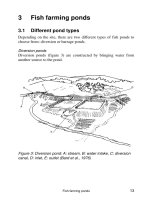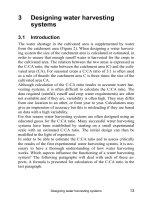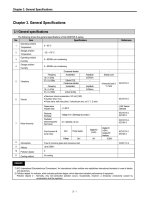Lecture Radio Communication Circuits: Chapter 3 & 4 - Đỗ Hồng Tuấn
Bạn đang xem bản rút gọn của tài liệu. Xem và tải ngay bản đầy đủ của tài liệu tại đây (1.88 MB, 73 trang )
Chapter 3:
Low Noise Amplifier (LNA)
Dept. of. Telecomm. Eng.
Faculty of EEE
CSD2013
DHT, HCMUT
References
[1] J. Rogers, C. Plett, Radio Frequency Integrated Circuit Design,
Artech House, 2003.
[2] W. A. Davis, K. Agarwal, Radio Frequency Circuit Design, John
Wiley & Sons, 2001.
[3] F. Ellinger, RF Integrated Circuits and Technologies, Springer
Verlag, 2008.
Dept. of. Telecomm. Eng.
Faculty of EEE
2
CSD2013
DHT, HCMUT
Origin of Noise (1)
Resistor thermal noise: Probably the most well known noise source is
the thermal noise of a resistor (also called Johnson noise). It is generated
by thermal energy causing random electron motion. It is white noise since
the PSD of the noise signal is flat throughout the frequency band.
The noise is also called Gaussian which means the amplitude of the noise
signal has random characteristics with a Gaussian distribution. We are
able to apply statistic measures such as the mean square values. The
noise power is proportional to absolute temperature.
The thermal noise spectral density in a resistor is given by
where k is Boltzmann’s constant (∼ 1.38 × 10−23 J/K), T is the absolute
temperature in Kelvin temperature of the resistor, and R is the value of the
resistor.
Dept. of. Telecomm. Eng.
Faculty of EEE
3
CSD2013
DHT, HCMUT
Origin of Noise (2)
Noise power spectral density is expressed using volts squared per hertz
(power spectral density). In order to find out how much power a resistor
produces in a finite bandwidth of interest ∆f , we use:
where vn is the rms value of the noise voltage in the bandwidth ∆f . This can
also be written equivalently as a noise current rather than a noise voltage:
Maximum power is transferred to the load when RLOAD is equal to R. Then
vo is equal to vn /2. The output power spectral density Po is then given by
Thus, available noise power is kT, independent of resistor size. Note that
kT is in watts per hertz, which is a power density.
Dept. of. Telecomm. Eng.
Faculty of EEE
4
CSD2013
DHT, HCMUT
Origin of Noise (3)
To get total power out Pout in watts, multiply by the bandwidth, with the
result that:
Dept. of. Telecomm. Eng.
Faculty of EEE
5
CSD2013
DHT, HCMUT
Origin of Noise (4)
Available power from antenna: The noise from an antenna can be modeled
as a resistor. Thus, the available power from an antenna is given by:
at T = 290K, or in dBm per hertz:
Example: For any receiver required to receive a given signal bandwidth, the
minimum detectable signal can now be determined. From Pout = kTB, the
noise floor depends on the bandwidth. For example, with a bandwidth of
200 kHz, the noise floor is
or in dBm:
Dept. of. Telecomm. Eng.
Faculty of EEE
6
CSD2013
DHT, HCMUT
Origin of Noise (5)
Thus, we can now also formally define signal-to-noise ratio (SNR). If the
signal has a power of S, then the SNR is
Thus, if the electronics added no noise and if the detector required a SNR of
0 dB, then a signal at -121 dBm could just be detected. The minimum
detectable signal in a receiver is also referred to as the receiver sensitivity.
However, the SNR required to detect bits reliably (e.g., bit error rate (BER)
= 10-3) is typically not 0 dB. Typical results for a bit error rate of 10-3 (for
voice transmission) is about 7 dB for quadrature phase shift keying
(QPSK), about 12 dB for 16 quadrature amplitude modulation (QAM), and
about 17 dB for 64 QAM. For data transmission, lower BER is often
required (e.g., 10-6), resulting in an SNR requirement of 11 dB or more for
QPSK.
Dept. of. Telecomm. Eng.
Faculty of EEE
7
CSD2013
DHT, HCMUT
Origin of Noise (6)
Shot noise: Shot noise is generated if current flows through a potential
barrier such as a pn junction. The square root of the shot noise current
can be described by
=
ish2 2qI dc ∆f
with q as the electron charge. As expected, the shot noise increases with
DC current Idc since it determines the number of available carriers.
Thus, shot noise can be minimised by reducing the DC current. However,
a reduced DC current may decrease the maximum possible gain and large
signal properties of transistors. Consequently, a tradeoff has to be found.
Shot noise plays an important role in BJTs since they consist of pn
junctions (especially for the forward biased base emitter junction).
Dept. of. Telecomm. Eng.
Faculty of EEE
8
CSD2013
DHT, HCMUT
Origin of Noise (7)
Usually, the shot noise of FETs is very small since there are no relevant
pn-junctions, and the current flowing through them is weaker than for
BJTs. However, the aggressively scaling of MOSFETs can introduce a
significant current from the gate to the channel, which may generate shot
noise.
In contradiction to thermal noise, shot noise does not occur in an ideal
resistor.
Dept. of. Telecomm. Eng.
Faculty of EEE
9
CSD2013
DHT, HCMUT
Origin of Noise (8)
1/f Noise: This type of noise is also called flicker noise, or excess
noise. The 1/f noise is due to variation in the conduction mechanism, for
example, fluctuations of surface effects (such as the filling and emptying
of traps) and of recombination and generation mechanisms. Typically,
the power spectral density of 1/f noise is inversely proportional to
frequency and is given by the following equation:
where m is between 0.5 and 2, α is about equal to 1, and K is a process
constant.
The 1/f noise is dominant at low frequencies, however, beyond the
corner frequency (shown as 10 kHz, see the diagram next slide), thermal
noise dominates. The effect of 1/f noise on RF circuits can usually be
ignored.
Dept. of. Telecomm. Eng.
Faculty of EEE
10
CSD2013
DHT, HCMUT
Origin of Noise (9)
An exception is in the design of oscillators, where 1/f noise can modulate
the oscillator output signal, producing or increasing phase noise. The 1/f
noise is also important in direct down-conversion receivers, as the output
signal is close to DC. Note also that 1/f noise is much worse for MOS
transistors, where it can be significant up to 1 MHz.
Dept. of. Telecomm. Eng.
Faculty of EEE
11
CSD2013
DHT, HCMUT
Noise in Bipolar Transistors (1)
Small-signal equivalent circuit of BJT at hight frequencies (without
noise):
rb = rbb‘, rπ = rb‘e, Cπ = Cb‘e, Cµ = Cb‘c ,
Dept. of. Telecomm. Eng.
Faculty of EEE
12
CSD2013
DHT, HCMUT
Noise in Bipolar Transistors (2)
Base shot noise: Consider shot noise (ibn or vbn) at the base of BJT.
Base shot noise is related to thermal noise in the resistor rπ as
Dept. of. Telecomm. Eng.
Faculty of EEE
13
CSD2013
DHT, HCMUT
Noise in Bipolar Transistors (3)
BJT with base shot noise, collector shot noise, and thermal noise at rb:
Small-signal equivalent circuit of BJT with noise:
Dept. of. Telecomm. Eng.
Faculty of EEE
14
CSD2013
DHT, HCMUT
Noise Figure (1)
Noise from the electronics (e.g. thermal noise, shot noise…) is described
by noise factor F, which is a measure of how much the signal-to-noise
ratio is degraded through the system. We note that:
where Si is the input signal power, So is the output signal power, and G is
the power gain So/Si. Then, the noise factor is:
where No(total) is the total noise at the output. If No(source) is the noise at the
output originating at the source, and No(added) is the noise at the output added
by the electronic circuitry, then we can write:
Dept. of. Telecomm. Eng.
Faculty of EEE
15
CSD2013
DHT, HCMUT
Noise Figure (2)
Noise factor can be written in useful alternative form:
This shows that the minimum possible noise factor, which occurs if the
electronics adds no noise, is equal to 1.
Noise figure NF is related to noise factor F by:
Thus, an electronic system that adds no noise has a noise figure of 0 dB.
Dept. of. Telecomm. Eng.
Faculty of EEE
16
CSD2013
DHT, HCMUT
Noise Figure (3)
The Noise Figure of an amplifier circuit: It is assumed that all practical
amplifiers can be characterized by an input-referred noise model, such as
the figure below, where the amplifier is characterized with current gain Ai.
In this model, all noise sources in the circuit are lumped into a series noise
voltage source vn and a parallel current noise source in placed in front of a
noiseless circuit.
Dept. of. Telecomm. Eng.
Faculty of EEE
17
CSD2013
DHT, HCMUT
Noise Figure (4)
If the amplifier has finite input impedance, then the input current will be
split by some ratio α between the amplifier and the source admittance Ys:
Assuming that the input-referred noise sources are correlated, the output
signal-to-noise ratio is:
Thus, the noise factor can now be written in terms of the preceding two
equations:
Dept. of. Telecomm. Eng.
Faculty of EEE
18
CSD2013
DHT, HCMUT
Noise Figure (5)
In general, two input noise sources will not be correlated with each other, but
rather the current in will be partially correlated with vn and partially
uncorrelated. We can expand both current and voltage into these two explicit
parts:
In addition, the correlated components will be related by the ratio
where Yc is the correlation admittance.
Thus, the noise figure is now written as
Dept. of. Telecomm. Eng.
Faculty of EEE
19
CSD2013
DHT, HCMUT
Noise Figure (6)
or
This equation can be used not only to determine the noise figure, but also to
determine the source loading conditions that will minimize the noise figure.
Differentiating with respect to GS and BS and setting the derivative to zero
yields the following two conditions for minimum noise (Gopt and Bopt):
Dept. of. Telecomm. Eng.
Faculty of EEE
20
CSD2013
DHT, HCMUT
Noise Figure (7)
Noise Figure of stages in series: Consider three stages in series as
The output signal So is given by:
The input noise is:
The total output noise is:
The output noise due to the source is:
Dept. of. Telecomm. Eng.
Faculty of EEE
21
CSD2013
DHT, HCMUT
Noise Figure (8)
Finally, the noise factor can be determined as:
The above formula shows how the presence of gain preceding a stage
causes the effective noise figure to be reduced compared to the measured
noise figure of a stage by itself. For this reason, we typically design
systems with a low-noise amplifier at the front of the system.
Question: Derive the formula for N stages in series?
Dept. of. Telecomm. Eng.
Faculty of EEE
22
CSD2013
DHT, HCMUT
LNA Design (1)
Introduction: The LNA is the first block in most receiver front ends. Its
job is to amplify the signal while introducing a minimum amount of
noise to the signal.
Gain can be provided by a single transistor. Since a transistor has three
terminals, one terminal should be ac grounded, one serves as the input,
and one is the output. There are three possibilities, as shown below:
Dept. of. Telecomm. Eng.
Faculty of EEE
23
CSD2013
DHT, HCMUT
LNA Design (2)
The common-emitter (CE) amplifier is most often used as a driver for an
LNA. The common-collector (CC), with high input impedance and low
output impedance, makes an excellent buffer between stages or before the
output driver. The common-base (CB) is often used as a cascode in
combination with the common-emitter to form an LNA stage with gain to
high frequency (as will be shown).
The loads of the circuits can be made either with resistors for broadband
operation, or with tuned resonators for narrow-band operation.
Dept. of. Telecomm. Eng.
Faculty of EEE
24
CSD2013
DHT, HCMUT
LNA Design (3)
Common-Emitter (CE) amplifier (Driver): For the analysis of the
common-emitter amplifier, we replace the transistor with its small-signal
model, as shown below, where ZL represents some arbitrary load that the
amplifier is driving.
At low frequency, the voltage gain of the amplifier can be given by:
where re is the small-signal base-emitter diode resistance as seen from
the emitter. Note that rπ = β re and gm = 1/re. For low frequencies, the
parasitic capacitances have been ignored.
Dept. of. Telecomm. Eng.
Faculty of EEE
25
CSD2013
DHT, HCMUT









